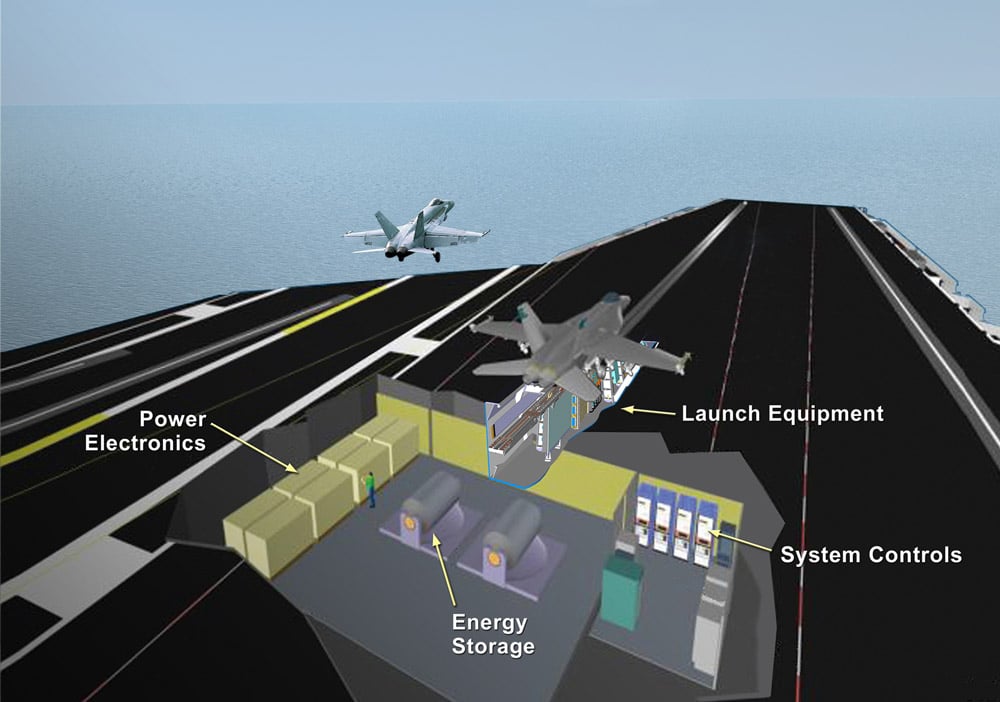
President Donald Trump again called to install steam catapults on future aircraft carriers, in a move experts say would cost billions of dollars and reduce the capital ships’ capabilities.
Trump, who has been critical of the Ford-class carriers’ new electromagnetic aircraft launch system (EMALS) system, said he prefers the steam-powered catapults found on the older Nimitz-class CVNs. He again called on the Navy to revert back to the old technology while speaking to naval forces in Japan over the Memorial Day weekend.
Tuesday, while visiting sailors and Marines aboard amphibious assault ship USS Wasp (LHD-1), Trump faulted EMALS for causing delays and cost overruns on the first-in-class USS Gerald R. Ford (CVN-78).
“We’re spending all that money on electric, and nobody knows what it’s going to be like in bad conditions,” Trump said in his speech. “I’m going to just put out an order, we’re going to use steam.”
However, installing steam catapults on a Ford-class hull is not so simple. Ford-class hulls were designed to accommodate an entire power system that doesn’t rely on steam pipped throughout the ship. Instead, the power generated from the nuclear reactors drive turbines that power a shipwide electrical grid. Space on the ships is allocated differently because there’s no need for all the steam piping found on Nimitz-class ships.
“The Navy would have to spend several billion dollars to redesign the ship,” Bryan Clark, a senior fellow at the Center for Strategic and Budgetary Assessments, told USNI News on Tuesday.
More than a decade ago, the Navy spent $1.3 billion on Ford-class design work, according to the Northrop Grumman 2006 annual report. Northrop Grumman later spun off its shipbuilding business into what is now Huntington Ingalls Industries, the Ford-class builder.
The Navy would have to look at USS George H.W. Bush (CVN-77), the last Nimitz-class carrier built, for design ideas. But the Navy can’t just use old Nimitz-class plans because of other new technologies developed since Bush was built, Clark said. The Navy would need to create a Ford-class and Nimitz-class hybrid.
The Navy does have some time before needing a new carrier plan. Ford has already delivered and the next carrier, John F. Kennedy (CVN-79), is due to be christened later this year. Next in line is Enterprise (CVN-80), which is already too far along in construction to try installing a steam catapult system, while the yet-to-be-named CVN-81 was paid for as part of a block buy with Enterprise and will be identical to Enterprise, retired Capt. Tal Manvel told USNI News. Manvel was part of the Ford-class design effort a decade ago.
The first chance for steam catapults would be CVN-82, Manvel said, “which isn’t scheduled to begin construction until 2028.”
Other considerations include the Navy’s other planned big-ticket purchases, Manvel said. The Columbia-class ballistic-missile submarine program and proposed medium and large surface combatant programs will all require billions of dollars of design work. Manvel isn’t sure there would be much of an appetite on Capitol Hill to also fund re-inventing a ship class that just entered production.
Cost aside, Clark and Manvel said there are capability-driven reasons to stick with the Ford-class design.
The Ford class incorporates new technologies designed for ships that are not configured to accommodate steam. An example, Clark said, is directed energy. If laser weapons, which require a significant amount of power to operate, are put on a ship with steam catapults, operating both becomes a problem, he said. But a ship that is optimized to produce electrical power could operate the flight deck and a laser weapon.

Long-term, the Ford-class design is supposed to save the Navy money over the life of the ship compared to the cost of operating Nimitz-class carriers, according to a May Congressional Research Service report.
“The Ford-class design uses the basic Nimitz-class hull form but incorporates several improvements, including features permitting the ship to generate more aircraft sorties per day, more electrical power for supporting ship systems, and features permitting the ship to be operated by several hundred fewer sailors than a Nimitz-class ship, reducing 50-year life-cycle operating and support (O&S) costs for each ship by about $4 billion compared to the Nimitz-class design, the Navy estimates,” the CRS report states.
EMALS is easier than steam catapults to calibrate for different types of aircraft, which becomes essential as the Navy moves toward incorporating lighter unmanned aircraft into the air wing, Manvel said.
“EMALS works,” Manvel said. “Still has some wrinkles to smooth out, but it works well.”





